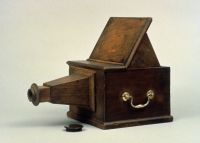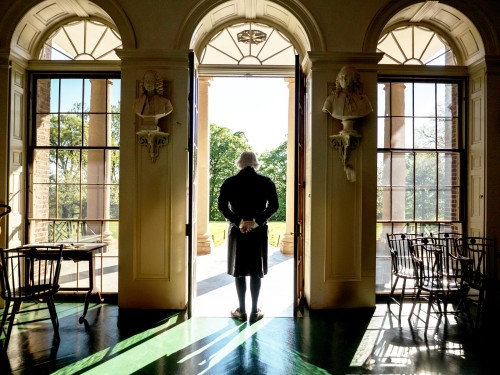 Artist/Maker: Unknown
Artist/Maker: Unknown
Created: late 18th century
Origin/Purchase: United States and England
Materials: mahogany, glass
Dimensions: 25.2 × 27.9 (53.3 with lens extended) × 19.1 (9 15/16 × 11 [21 in. with lens extended] × 7 1/2 in.)
Location: Parlor
Provenance: Thomas Jefferson; by descent to Thomas Jefferson Randolph; by descent to Mrs. Hollins N. Randolph; by purchase to the Thomas Jefferson Foundation in 1938
Accession Number: 1938-4
Historical Notes: The camera obscura, the device that led to the invention of photography, served many purposes in the eighteenth century—from the scientific uses of viewing sunspots or demonstrating the nature of vision, to serving the needs of engravers or traveling landscape artists. It could be enjoyed for the heightened effect of the scene in miniature that appeared on the viewing glass—a picture "drawn by nature's hand," as Benjamin Martin described it in 1740.[1]
Jefferson's instrument is a reflex camera obscura. The movable lens projects an inverted image onto an interior mirror, which reflects an upright, but reversed, image onto the glass viewing plate. It may be the instrument he bought in 1794 from David Rittenhouse, after borrowing it a few months earlier so that his daughter Maria could "take a few lessons in drawing from nature."[2]
For Jefferson, drawing was an important part of female education, "an innocent & engaging amusement, often useful, and a qualification not to be neglected in one who is to become a mother & an instructor."[3] His own drawing activities, beyond his notable architectural draftsmanship, are less clear. The only nonarchitectural drawings that survive are simple sketches of furniture or farm equipment, meant solely as aids to craftsmen or his own memory. He did, however, have an active interest in devices that assisted in drawings that survive directly from life. While in Europe, he purchased a "perspective machine" to aid in drawing objects and landscapes.[4]
In London in 1786 Jefferson bought a scioptric ball, which could be fitted to a window shutter to turn a darkened room into a camera obscura. The previous day he had visited Alexander Pope's grotto at Twickenham and must have recalled Pope's famous description of it in 1725, when it could be turned into a camera obscura providing a "moving Picture" of traffic on the Thames. Jefferson may also have seen the room camera obscura at the Greenwich Observatory when he stopped there three weeks later on his way back to France.[5]
It is not known just why Jefferson commissioned the purchase of a second instrument in 1805.[6] Geographer William Tatham (1752-1819) procured for him in London "A Camera Obscura, with Extra Glasses constructed in the best manner by Adams" and costing £10-10.[7] It arrived at the President's House just in time for the visit of Jefferson's daughter Martha and her children, and it may have been purchased to provide amusement for this extended winter visit.
Three years later, after "revising" his collection of scientific instruments, Jefferson gave one of his camera obscuras to his son-in-law John Wayles Eppes for the future use of his grandson Francis, then aged eight.[8] Although there are no references to the camera obscura's use in making silhouettes, the survival of a large number of unsigned silhouettes suggests the possibility that some were made with the assistance of this instrument.
1793 September 6. (Jefferson to David Rittenhouse). "Th: Jefferson presents his friendly respects to Mr. Rittenhouse. He has two young ladies [Maria Jefferson and Sarah Cropper] at his house whose time hangs heavily on their hands, and the more so, as their drawing master cannot attend them. If Mr. Rittenhouse then does not take his Camera obscura with him into the country, Th:J. will thank him to permit them the use of it a few days, that they may take a few lessons in drawing from nature."[9]
1794 January 3. "Drew the following orders as paiments in favor of ... D. Rittenhouse for odometer & cam. obsc. 39.94."[10]
1805 June 15. (William Tatham to Jefferson). "He [Tatham] has written to Messrs. Learmonth’s & Berry, (the House he is concerned for) Merchts. in London, for a Camera Obscura for the President’s use, to be made as elegantly Plain as possible, by the best Workmen, with spare Glasses of several focuses, Diagonal Head, &c, compleat. ... he cannot say what the Price will be. He will, however, look for the Bill of the One he has, by which any importer will be able to settle an approximate Price ... W. T. will thank the President to spare the One he has, a day or two, as Mrs. Merry has expressed a desire to see it before she leaves Town for the Hot Season. It shall be sent back again immediately, after he has gratified the Curiosity of his Amiable friend."[11]
1805 August 19. (Learmonth-Berry to William Tatham). "Agreeably to your order, we have shipped ... [to] Norfolk a Camera Obscura, constructed by Adams (our best Maker here) for your President."[12]
1805 November 9. (Jefferson to Mordecai Miller). "A letter from mr Warren Ashley of Norfolk informs me that a case sent from London to his care for me, had been forwarded to you. ... I presume it contains a camera obscura, as I expected one from London."[13]
1805 November 24. "Paid Colo. Wm. Tatham for a Camera obscura 78.84 D."[14]
1808 June 4. (Jefferson to John Wayles Eppes). "In revising my philosophical apparatus I find I have some articles to spare which will be of use to Francis when he comes to that part of his education, and may in the mean time amuse yourself. these are ... a Camera obscura, for drawing. These instruments are perfect, and of the best kind, having been bought by myself in London, when I was there. they cost there about 140. or 150. D. and could not be bought here for less than double that sum."[15]
1826 October 4. (Joseph Coolidge to Nicholas Philip Trist). "Cornelia will find, too, her ground pane of glass, for the camera obscura. She might indeed have procured the same at Charlottesville without delay, for tis nothing more than window glass ground; which is a simple thing and to be done by anyone."[16]
- Text from Stein, Worlds, 426
ADDRESS:
931 Thomas Jefferson Parkway
Charlottesville, VA 22902
GENERAL INFORMATION:
(434) 984-9800
